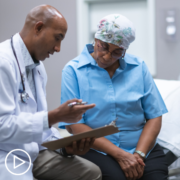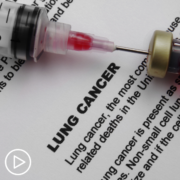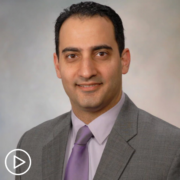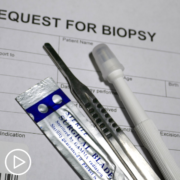Improving Biomarker Testing Access for Rural Lung Cancer Patients
Improving Biomarker Testing Access for Rural Lung Cancer Patients from Patient Empowerment Network on Vimeo.
What are the barriers for rural patients hoping to access biomarker tests? Dr. Samuel Cykert discusses the barriers for underrepresented lung cancer patients in rural areas face in accessing biomarker testing, citing issues like health insurance, economics, and language.
Download Resource Guide | Descargar guía de recursos
See More from [ACT]IVATED Non-Small Cell Lung Cancer
Related Resources:

|

How Can We Advance Equitable Access to Precision Medicine in Lung Cancer Care? |

What Urgent Innovations Can Advance Lung Cancer Precision Medicine? |
Transcript:
Lisa Hatfield:
Dr. Cykert, one of the main barriers preventing Black and Latinx patients with lung cancer in rural areas from accessing biomarker testing, and what steps can be taken to address these barriers, including improving awareness, affordability, and availability of testing facilities?
Dr. Samuel Cykert:
Yeah, great, great question. There are several issues here. One is the issue of rural, and the other issue is patients of color who may have barriers of health insurance, barriers of economics, barriers of education, and especially in the case of Latinx folks, barriers of language. So it really is a multiple question, but one thing for sure is we know from past studies that technology diffusion is slow and tends to get out to rural areas later than other areas, and the other problem is treatment volume in rural areas.
So a lot of rural hospitals don’t do bio specimen testing, don’t have the capability of doing that, and so you have this kind of double whammy of low volume testing plus low volume treatment, it’s well-known that surgeons who do more operations, for instance, do better. So given all those factors, I would recommend that rural patients who have presumptive diagnosis of lung cancer, even a suspicion of lung cancer, for instance, a large mass, a greater than 2 centimeter mass on an x-ray or a CT scan, that those patients ask to be referred to the closest high volume center.
I think that’s an important step, and we also have to have close interactions with our rural colleagues so that they’re comfortable of treating aggressively things that are well-treatable in the rural environment and going on to the high-volume centers, the more specialized centers, when things have to be done more aggressively.
When you look at a lot of different healthcare disparities, especially in advanced diseases, a lot of them come from being in areas where technology diffusion hasn’t happened and people don’t have access to the same treatments that they do at higher volume centers. My activation tip here is, for things like biomarker testing and advanced treatments, you need to go to the closest high volume center.
Share Your Feedback
Create your own user feedback survey












